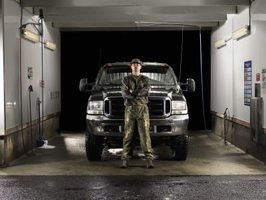Inside an internal combustion engine and milled into the engine block are small ports which allow engine coolant to circulate throughout the metal block. The coolant pumped through these passages removes heat from the engine block and transfers the heat to the radiator where it’s dissipated into the surrounding air. The anti-freeze liquid also carries heat to the vehicle’s heater core, which operates the heater inside the vehicle’s passenger compartment. The rear water crossover is one of these internal coolant passages.
Coolant Circulation
-
Three water crossover passages are milled inside an engine’s intake manifold. As antifreeze/coolant flows through these passages, heat is removed from the intake manifold. The rear water crossover flows from the right side of the engine to the left side of the engine behind the motor’s carburetor. Mechanics who are unfamiliar with the engine assume that all three passages are essential to the vehicle’s operation. Their assumption is incorrect. The rear water crossover is not a necessary cooling liquid passage, and in many engines the rear of water crossover is blocked by the vehicle’s distributor.
Temperature Monitoring
-
Without a rear water crossover passage from the left side to the right side of the motor, coolant flows up through the intake manifold via the front and middle water crossover. The rear water passages in the cylinder heads can be tapped for temperature-monitoring devices, such as thermostats, thermocouples, or temperature gauges. The coolant which flows through the center and the forward water crossover adequately removes heat from the intake manifold.
Aftermarket Parts Installation
-
Many mechanics only discover the missing rear water crossover when rebuilding a vehicle’s motor, or when replacing the OEM intake manifold with a high-performance aftermarket product. Mechanics are surprised to discover the rear water crossover is not milled into the aftermarket intake manifold.
Interchangeable Parts During Assembly
-
During the automotive design process, engineers make decisions regarding the cost-effectiveness of their products. The rear water crossover passages milled into the motor block’s cylinder heads give the manufacturer strategic and financial assembly line advantages. Since the rear water crossovers are not essential, the right side and left side cylinder heads can be installed interchangeably. These parts mirror each other, which simplifies the motor assembly process. By designing the cylinder head with a front and rear water crossover passage, one part can be installed on the left or the right side of the motor.
Manufacturing Cost Savings
-
The rear water coolant passage which is milled into the cylinder head also gives the manufacturer the opportunity to tap this area for the vehicle’s heater hose connections. The vehicle’s heater core is connected to the motor close to the passenger compartment. By using the rear water coolant passage in the cylinder head, the company can use smaller lengths of feeder hose to complete the connections. In the long run, shorter lengths of the heater hose save the company hundreds of thousands of dollars over the life of the vehicle.
